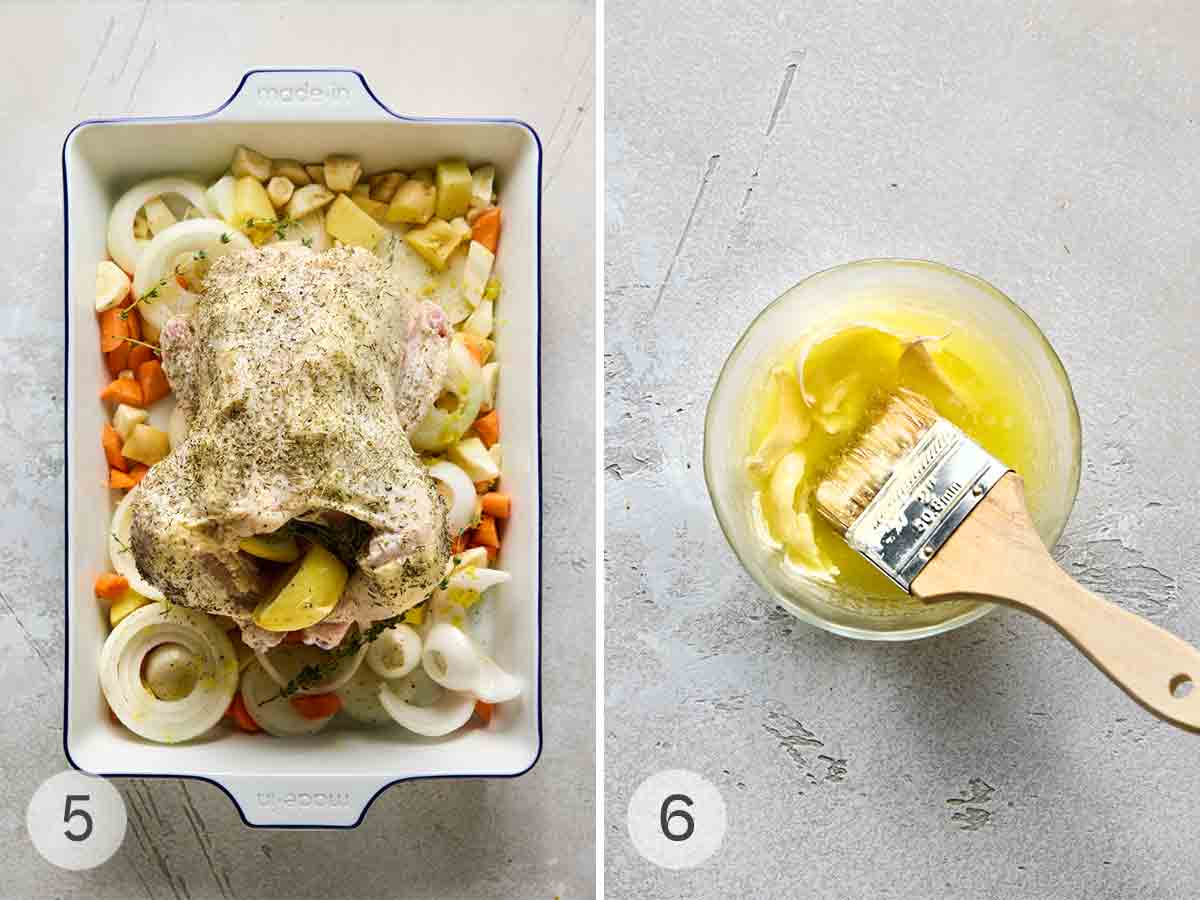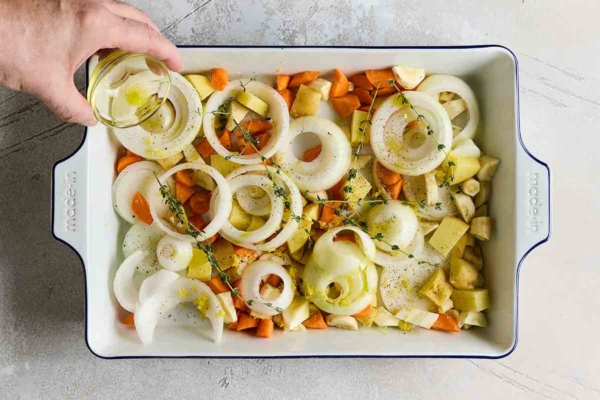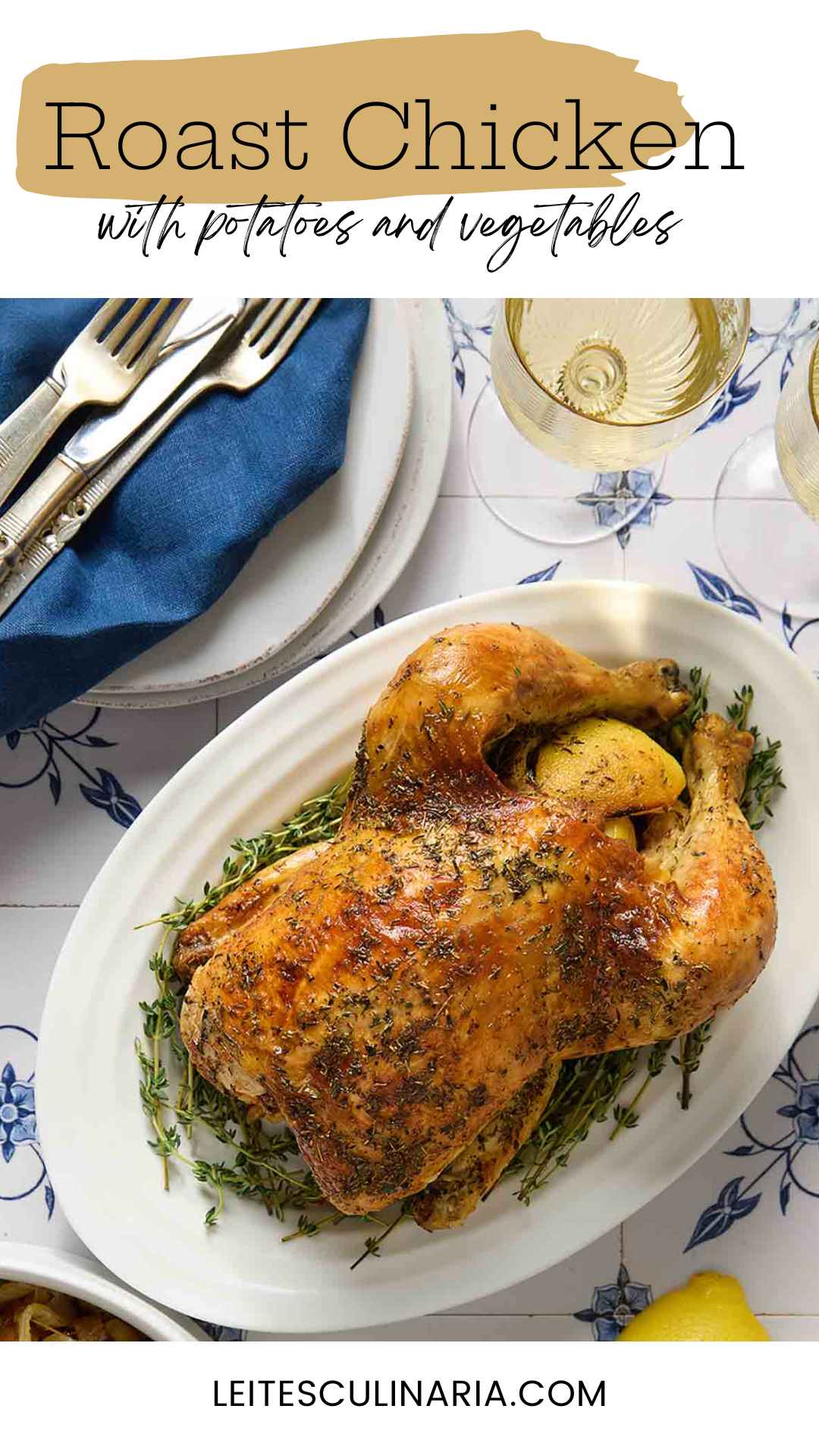
This approach to roast chicken is like a French woman’s approach to tossing a scarf around her neck. With little effort but just the right technique, something incredibly simple and commonplace is suddenly made sophisticated.
That’s what happens when you slip some lemon, herbs, and root vegetables in with your plain old hen: a more beautiful roasted bird. And no one has to know just how simple it is. Just nod and graciously accept the compliments.
Jump To

Why Our Testers Loved This
My testers gushed over this simple French roast chicken recipe that “has it all–tender, juicy meat bursting with flavor and wonderful, crisp skin, and the roasted veggies bathed in rich buttery-lemon-garlic-chicken juices!” Makes you want to try it, doesn’t it?
Notes on Ingredients

- Root vegetables–Use any combination of your favorite root veggies, including potatoes, carrots, parsnips, or turnips. Cut them into similar-sized pieces so that they cook evenly.
- Chicken–Buy a chicken between 3 and 4 pounds, often labeled as a fryer chicken. Larger roasting chickens provide more meat but take longer to cook, and you may end up with overly crispy chicken or vegetables.
- Lemons–These add flavor to the chicken while it roasts. Leaving them in large wedges keeps the lemon flavor subtle.
- Salted butter—Using salted butter saves you the step of salting the chicken. If you’re using unsalted butter, sprinkle a big pinch of salt inside the cavity of the chicken and season the outside of the chicken well after rubbing it with butter. Room-temperature butter will be much easier to spread than cold butter, so be sure to take it out of the fridge a couple of hours before cooking.
- Garlic—Smash the cloves of garlic cloves in their skins by laying each one on its side and pressing firmly on it with the flat side of a large knife. Keeping them in their skins allows the garlic to infuse the chicken and butter with flavor without overpowering it.
How to Make French Roasted Chicken

- Combine the vegetables, onions, oil, lemon zest, thyme, salt, and pepper in a roasting pan. Mix well to coat everything, then arrange in a single layer.
- Pat the chicken dry using paper towel.

- Quarter the lemons and stuff them inside the chicken cavity with the smashed garlic and some thyme.
- Rub half of the butter under the chicken’s skin, then spread the remainder over the outside. Sprinkle herbes de Provence and pepper over the chicken.

- Place the chicken on top of the vegetables.
- Melt the butter in a small saucepan. Add the smashed garlic and keep warm.
- Roast the chicken at 425°F until the skin begins to brown. Reduce the heat to 400°F and cook, basting every 20 minutes with the garlic butter, until it reaches an internal temperature of 165°F.

Want to Save This?
Common Questions
The best way to determine doneness is with a meat thermometer. Insert it into the thickest part of the thigh, avoiding any bone. When it reads 165°F (74°C), the chicken is done.
Begin by laying your cooked chicken on a flat surface. Using a sharp knife, cut between the leg and the breast until you reach the hip joint. Press firmly to cut through the joint while gently pulling the leg away. Cut between the drumstick and thigh, and repeat with the second leg.
To carve the breast, slice into the top of the breast next to the breastbone. Guide the knife along the bone towards the ribs while gently pulling the breast away from the bone. Follow the ribs until you reach the wing joint, and press firmly to cut through the joint, then separate the wing from the breast.
Slice the chicken breast, if desired, and repeat with the remaining breast.
It’s up to you. Trussing the chicken can help it to cook more evenly, but it’s not required for this recipe.
What to Serve with This Recipe
Since you’ve got juicy, tender chicken and caramelized root vegetables in one dish, all you need to add is a crisp green salad drizzled with tangy lemon vinaigrette. That said, I’d never turn down a loaf of crusty artisan bread for sopping up the buttery juices. Or, if you want to add a touch of indulgence to your French meal, serve potatoes Dauphinoise on the side. It makes a great Mother’s Day recipe, too!
Pro Tips & Troubleshooting
- With so few ingredients, it’s important to find the best quality chicken you can.
- If your chicken is browning too quickly, cover it loosely with aluminum foil.
- Save your chicken carcass for making slow cooker chicken stock.
Storage and Reheating
Leftover chicken can be stored in a sealed container in the refrigerator for up to 4 days. Reheat it in a 300°F oven until warmed through.

Write a Review
If you make this recipe, or any dish on LC, consider leaving a review, a star rating, and your best photo in the comments below. I love hearing from you.–David
This was amazing. It was so easy to make, and the roasted vegetables in the juices were out of this world. We may never go back to grocery-store roast chicken again.
Karen W.

French Roast Chicken ~ Poulet Rôti
Ingredients
For the chicken
- 2 to 3 cups roughly chopped assorted root vegetables (carrots, parsnips, potatoes)
- 2 medium yellow onions, thickly sliced
- 2 tablespoons olive oil
- 2 small lemons, preferably organic, zest grated from 1
- 6 sprigs fresh thyme
- 2 teaspoons flaky sea salt
- 1 teaspoon freshly ground black pepper
- One (3-pound) chicken
- 2 garlic cloves, unpeeled but smashed
- A few sprigs fresh thyme
- 4 tablespoons (2 oz) salted butter, at room temperature
- 1 to 2 teaspoons dried herbes de Provence or dried thyme
- Freshly ground black pepper
For basting
- 4 tablespoons (2 oz) salted butter
- 2 garlic cloves, unpeeled and smashed
Instructions
Make the chicken
- Preheat the oven to 425°F (220°C).
- Scatter the chopped vegetables and onions in a roasting pan and drizzle with the oil. Add the lemon zest, thyme, salt, and pepper to the vegetables and, using your hands, mix until all the vegetables are coated and then spread into a single layer.

- Using paper towels, pat the chicken completely dry, inside and out.

- Cut both lemons in quarters and tuck them in the cavity of the bird with the smashed garlic and a few sprigs of fresh thyme. If all the lemon quarters don’t fit, you can pop them in the pan with the vegetables—just don’t forget to take them out when you serve the chicken.

- Cut about half the butter into small pieces and place the pieces under the skin of the bird. To do this, start at the cavity end of the chicken and slide one or two fingers between the meat and the skin. Work slowly, separating the skin from the meat as far as you can reach. Squish the butter pieces slightly and fit them under the skin as best you can.
- Spread the remainder of the butter over the outside of the skin. The easiest way to do this is with your hands. Season the bird with the herbes de Provence or dried thyme and a touch of pepper.

- Place the bird directly on the vegetables in the roasting pan and place in the oven on the bottom rack for 20 minutes, until the skin starts to brown nicely.

Make the basting mixture
- In a small saucepan, melt the butter. Add the smashed garlic and place over very low heat. You will use this to baste the chicken while it’s roasting.

- Turn down the oven to 400˚F (200˚C) and roast the chicken for 60 to 70 minutes more, or until a meat thermometer inserted into the high part of the thigh registers 165˚F (74˚C). Normally you can count on about 20 minutes’ cook time per pound (454 g) of chicken but to be absolutely sure, a meat thermometer is the way to go!
- While the bird is cooking, baste it every 20 minutes or so with the melted butter and smashed garlic. This will season the bird even more.
To serve
- Once the chicken is cooked, remove it from the oven (leave the vegetables in the roasting pan), place it on a cutting board (preferably one that has a drain ridge to catch any juices), cover it loosely with aluminum foil and allow it to rest for about 10 minutes before you carve it.
- Give the vegetables a good stir and place the roasting pan back in the oven until you are ready to serve the meal. If the vegetables are not crisp enough, you can set the broiler to high (around 400˚F/200˚C, if your broiler has a temperature display) and broil them for about 5 minutes, but do keep an eye on them as they might burn.
Notes
- Choosing your chicken–With so few ingredients, it’s important to find the best quality chicken you can.
- Tenting the chicken–If your chicken is browning too quickly, cover it loosely with aluminum foil.
- Make stock–Save your chicken carcass for making slow cooker chicken stock.

Explore More with AI
Nutrition
Nutrition information is automatically calculated, so should only be used as an approximation.
Recipe Testers’ Reviews
This French roast chicken dish has it all—tender, juicy meat bursting with flavor, wonderful, crisp skin, and roasted veggies bathed in rich buttery lemon-garlic chicken pan juices! I’m still thinking about it!
The dish takes a bit of time from start to finish, but what a perfect meal to make for guests when all the work is done ahead. After guests arrive, all you have to do is peek in the oven and baste every now and then while you’re enjoying some cocktails with your friends.
The only accompaniment you need for this dish is a crisp salad with a bracing vinaigrette to cut through the richness of all that butter and a really good baguette.
This French roast chicken recipe turned out to be one I’ll reach for again and again. The result was a chicken full of flavor with crisp skin and moist flesh–even the white meat. But the star of the dish was the vegetables. The combination of lemon zest with fresh herbs, salt, and pepper was delicious and made me sorry there weren’t more morsels of carrot and potato to eat.
A classic and well-written roast chicken recipe! It just goes to show that basic ingredients cooked well can turn into a fabulous main course!
Don’t skip the basting with the garlic butter; it helps produce a beautiful golden brown, crispy skin. And definitely use a thermometer so you don’t overcook your bird! I made this on Monday for lunch and am looking forward to enjoying the rest of it during the week—so many possibilities!
This poulet roti is a wonderful dish to serve for dinner and is a big hit with adults and children. The chicken is incredibly moist with a delicious flavor.




















Where does anyone find 3-pound whole chickens? You’re kidding, right? I’m so tired of recipes that list impossible-to-find ingredients. This, 6-ounce boneless chicken breasts, hanger steak and so on. I’m a good cook and can adjust most of the time, but really? It’s so frustrating.
Russ, I hear you. I find them at my local natural food store. They weigh in at about 3.5 pounds. If you can’t find anything that small, get the smallest you can, and adjust up. But these chickens do exist! I can assure you!
This was amazing. So easy to make, and the vegetables in the juices were out of this world. We may never go back to grocery store roast chicken again.
Karen, we’re thrilled that this will replace the grocery store buy. Please let us know what you make next.
The recipe turned out wonderfully until I followed the step “cover it loosely with aluminum foil” where the beautiful crispy skin turned to goo. I cooked again later and ignored the “covering” step” and the recipe was perfect.
Hi Jim. Cover or not to cover—there seem to be two schools when it comes to resting cooked meats. Those who leave them uncovered do so exactly to eliminate any possibility of steam building up, so that the crisp skin or the crust would be preserved. Thank you for trying the recipe twice and letting us know which worked better in your kitchen!